The story of Haiti’s struggle to survive and thrive amid devastation
By Richard B. Muhammad -Editor-in-Chief | Last updated: Feb 17, 2010 - 11:42:57 AMWhat's your opinion on this article?
Nation's spirit unbroken as her people accept challenge to rebuild capitalRelated news:
No more broken promises for Haiti (FCN, 02-17-2010)
Editors' Notebook from Haiti (FCN Photo Essay)
Farrakhan calls for National Mobilization for Haiti (FCN, 01-19-2010)
Analyzing Haiti's history of hardship (Web Video, 01-14-2010)
Naomi Klein issues warning on "Disaster Capitalism" in Haiti (FCN, 01-14-2010)
Disaster hits Haiti: Magnitude 7.0 Earthquake (FCN, 01-13-2010)
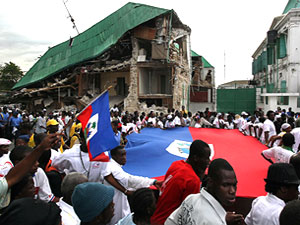
A crowd passes the destroyed Ministry of Public Works while marching in a ceremony in rememberance of earthquake victims on February 14, in Port-au-Prince, Haiti. Thousands of people gathered for a ceremony which concluded a three-day period of mourning to mark a month since the January 12 earthquake. Photo: John Moore/Getty Images
‘Certainly this earthquake was an equal opportunity devastator and to rebuild Haiti it has to be all hands on deck.’ —Dr. Ron Daniels, Haiti Support Project |
With a major earthquake a month ago, some 230,000 dead, hundreds of thousands displaced and many still struggling to find food and water, the capital remains in a crisis. Haitians need help, but aren't waiting around for anyone to come to the rescue.
“From day one the first people that responded to the cry of help was Haitians themselves, getting people out of the rubble. People have this will to survive and get the country back on track,” said Alex Georges, a Haitian businessman and tour operator.
“We were going on the right path so it was big blow but we have to stay strong and get back on track and you can feel that at every refugee or I would say victim camp. The people have the will and the desire to survive and they are not just waiting for help. They are trying to do whatever they can to survive in a positive way,” said Mr. Georges, who also works as a translator.
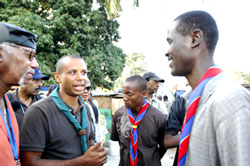
Alex Georges talks with Boy Scouts at tent city. Photos: Richard B. Muhammad
|
Life, it seems, must go on.
Amid the tents and the people are makeshift shops and kitchens. There is an outdoor clinic run by young Haitian medical students who live with their patients. Motorbikes are parked beside tents. Along nearby sidewalks are peddlers dealing everything from jewelry to bananas and from jeans, paintings and wood carvings to communications services.
Jean-Baptiste Jemmi was lucky enough for his home to survive the earthquake. The place where he worked was destroyed. Undeterred the 26-year-old is running a mobile cell phone charging station and mobile internet café from the back of a truck with a canopy overhead. For a few gourds, Haitian currency, people can access email, update Facebook pages, get information, connect with the outside world and recharge cell phones.
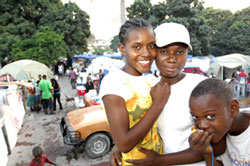
Children in camp for displaced Haitians.
|
Traffic jams in the city could be a good thing, a sign lives are under reconstruction.
A drive from the outskirts of the city to its center bypassed lines of women collecting food, trucks filled with items, markets packed with produce and goods and even crews repaving a road. It takes money, of course, to buy cell phones and cabbage or candles and shoes. Money is still scarce for many in this already poor country.
The lucky ones are back to work or are making a way for themselves on the streets, usually while sleeping on the streets. Thousands still line up at 16 emergency food sites run by the U.S. Agency for International Development and others managed by the many non-profits operating in the city.
Life is still hard, but the determination to live is fierce. Haitians remain unbowed as many face realities that could easily reduce grown men to tears.
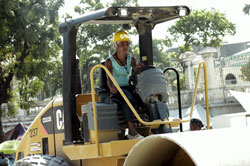
Woman operates steam roller in center of capital.
|
Some blocks were nothing but the remains of shattered structures, often with industrious Haitians scrounging and salvaging pieces of metal, bricks, furniture, documents or any useful item. Men were seen atop lopsided roofs and piles crumbled of concrete. Others busily repaired walls and painted over buildings that may have to be destroyed as the city will have to be rebuilt.
Women hawked their wares on the streets and one drove a steam roller, flattening a lot in center city.
The buildings and shops are so close together and the damage so widespread that a multi-year reconstruction plan is needed.
Patrick Delatour, the minister of tourism who is heading the Office of National Reconstruction, joked with Black journalists about Haitians building without builders and planning without planners. His countrymen's independence streak has been a cursing and a blessing—homes were built willy nilly without regard to city codes, plans or permits. But it had also been a couple hundred years since the last great earthquake.
The people are busy, but a collective plan is needed and in the works, said the Howard University graduate, who lost his parents in the disaster. From a building in the Pétionville section of city, where the toilet doesn't flush, he huddles with architects. He plots the new vision and tries to carry out the wishes of President René Preval.
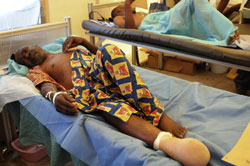
Patient at hospital in capital.
|
The top official told Black journalists the Préval government has ceded delivery of food, tents, medicine, clothing and other items to aid groups, charities and international groups helping out in the country. The government doesn't have the capacity to handle distribution and delivery, Mr. Delatour explained.
The major task is coordination of more than 400 large and small non-governmental groups or non-profits, he said.
Shorthanded government suffers a major disadvantage: The Jan. 12 quake killed several lawmakers, government ministers and personnel, policemen and those who do the daily work of administration. There are no secure bunkers here, so a bus ride around the city is a showcase for destroyed ministries—everything from the presidential palace, which is also the work space for the president, to the internal revenue service with tax and property records ruined. The parliament building caved in. Huge churches and cathedrals stand as shells of their former grand selves.
The disaster injured some 300,000 people with 700,000 people displaced and the disaster affected the lives of about three million people, say U.S. and Haitian officials. Eight thousand schools have been destroyed, according to Mr. Delatour.
Still, citing his country's history, Mr. Delatour stressed moving forward. Help from the international community is needed but projects in the pipeline after three years work need to continue, he said. Aid money should be for new projects, Mr. Delatour added.
“We have got to stay strongly engaged in the process in aiding and assisting Haiti over the next several months and even years to bounce back and to be built stronger and better,” commented Dr. Ron Daniels, founder of the Haiti Support Project and organizer of the journalists mission. He has been working in Haiti for 15 years.
“Certainly this earthquake was an equal opportunity devastator and to rebuild Haiti it has to be all hands on deck,” said Dr. Daniels, whose column Vantage Point is syndicated to Black and progressive outlets across the country. Money for ongoing projects needs to come in; legislation is needed to protect Haitian agriculture to rebound and all debt must be forgiven, he said.
This is the time for the long suffering Haitian people to be in the thick of the process and the people have already injected themselves into the process by starting to rebuild, said Dr. Daniels. He believes the time is ripe for the involvement of the masses.
Haitian institutions—whether the damaged State University Hospital—or makeshift aid stations provide services for people. People also care for one another as best they can.
Dr. Alex Lasseque, executive director of the State Hospital, which had tents on parking lots that served as triage centers, patient wards, laboratories and staff housing, said the emergency situation and crush injuries have largely been dealt with.
His current waves of patients standing quietly or sitting in long lines are largely coming in with pre-quake illness, like diabetes or asthma, or for follow ups to treatment or handling things like infections. Many Haitians had limbs amputated in the early aftermath of the earthquake.
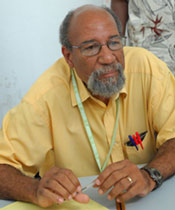
Dr. Alex Lasseque
|
Some of his staff members are living near their homes or in camps providing services, he said. Others have lost family, left the city or left the country. Humanitarian workers from different countries are helping out, with integrated teams, he said. These teams have also been dispatched to help people in camps around the city and the hospital sees 500-600 patients a day at the triage zone and does 20-50 operations a day, added Dr. Lasseque.
The hospital needs to be completely rebuilt, half of the buildings are not safe, he said. Before the quake the medical staff included 250 doctors, now there are just 50 doctors, 350 nurses and 500 support personnel, said the Haitian physician.
Some buildings and restaurants and hotels still stand and the wealthier neighborhoods in the hills were sometimes spared some damage. These establishments operate in a relatively normal way to be surrounded by rubble. Some street lights are on. Cars zoom up and down streets, competing for space with “tap tap” taxis and motorbikes that ferry passengers and goods across town and to its outskirts.
Sultane Bernard Ratchse, a onetime cosmetologist, lives in a camp. She clutched a pillow as she spoke with this writer, her beautiful 17-year-old daughter standing nearby. “No future, for the kids,” she said. Ms. Ratsche sees education as the way out for her children, but everything has collapsed. She has heard about aid but has received little. She understands the need is huge and others need help too. “Haiti has to be rebuilt, even with the aid in a few months what is going to happen once the aid is gone? We have to rebuild Haiti,” she said.
INSIDE STORIES AND REVIEWS
-
-
About Harriett ... and the Negro Hollywood Road Show
By Rabiah Muhammad, Guest Columnist » Full Story -
Skepticism greets Jay-Z, NFL talk of inspiring change
By Bryan 18X Crawford and Richard B. Muhammad The Final Call Newspaper @TheFinalCall » Full Story -
The painful problem of Black girls and suicide
By Charlene Muhammad -National Correspondent- » Full Story -
Exploitation of Innocence - Report: Perceptions, policies hurting Black girls
By Charlene Muhammad -National Correspondent- » Full Story -
Big Ballin: Big ideas fuel a father’s Big Baller Brand and brash business sense
By Bryan Crawford -Contributing Writer- » Full Story






 Click Here Stay Connected!
Click Here Stay Connected!








